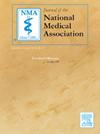The association of patient and clinician demographics and concordance with medicaid sterilization consent form validity
IF 2.5
4区 医学
Q1 MEDICINE, GENERAL & INTERNAL
引用次数: 0
Abstract
Objective(s)
To evaluate the association between patient demographics, clinician demographics, and concordance of patient-clinician demographics and Medicaid sterilization consent form validity, defined as the waiting period having elapsed.
Study Design
Secondary analysis of a large, multi-center retrospective cohort study. This analysis included patients with Medicaid insurance desiring postpartum permanent contraception across three study sites. Our primary outcome was Medicaid sterilization consent form validity. Patient demographics were abstracted from the electronic medical record. Clinician demographics were obtained both through self- and peer-report. Descriptive, random effects modeling, and multivariable logistic regression analyses were utilized.
Results
Of the 1644 patients delivered by 124 clinicians in our cohort, 840 (51 %) had a valid Medicaid sterilization consent form. Descriptively, patients who were Black, unmarried, and not college educated were more likely to have valid forms (p < 0.001). The religious affiliation of the clinician (p < 0.001), but no other clinician characteristics, was associated with form validity. In multivariable models, patients who were of a different racial identity than their clinicians were more likely to have a valid form (aOR 1.32, 95 % confidence interval (CI) 1.05–1.66).
Conclusion(s)
While unable to determine the causes of our findings, the differential proportion of Medicaid sterilization consent form validity based on patient characteristics is concerning. Differences in form validity based on patient-clinician racial and ethnic concordance is deserving of further study.
患者和临床医生的人口统计数据的关联以及与医疗补助绝育同意书有效性的一致性。
目的:评估患者人口统计学、临床医生人口统计学以及患者-临床医生人口统计学与医疗补助绝育同意书有效性(定义为等待期已过)的一致性之间的关系。研究设计:对一项大型多中心回顾性队列研究进行二次分析。该分析包括三个研究地点的医疗补助保险患者希望产后永久避孕。我们的主要结果是医疗补助绝育同意书的有效性。从电子病历中提取患者人口统计数据。通过自我报告和同行报告两种方式获得临床人口统计数据。采用描述性、随机效应模型和多变量logistic回归分析。结果:在我们的队列中124名临床医生接生的1644例患者中,840例(51% %)有有效的医疗补助绝育同意书。描述性地说,黑人、未婚、未受过大学教育的患者更有可能有有效的表格(p )结论(s):虽然无法确定我们发现的原因,但基于患者特征的医疗补助绝育同意书有效性的差异比例令人担忧。基于患者-临床医师种族和民族一致性的表格效度差异值得进一步研究。
本文章由计算机程序翻译,如有差异,请以英文原文为准。
求助全文
约1分钟内获得全文
求助全文
来源期刊
CiteScore
4.80
自引率
3.00%
发文量
139
审稿时长
98 days
期刊介绍:
Journal of the National Medical Association, the official journal of the National Medical Association, is a peer-reviewed publication whose purpose is to address medical care disparities of persons of African descent.
The Journal of the National Medical Association is focused on specialized clinical research activities related to the health problems of African Americans and other minority groups. Special emphasis is placed on the application of medical science to improve the healthcare of underserved populations both in the United States and abroad. The Journal has the following objectives: (1) to expand the base of original peer-reviewed literature and the quality of that research on the topic of minority health; (2) to provide greater dissemination of this research; (3) to offer appropriate and timely recognition of the significant contributions of physicians who serve these populations; and (4) to promote engagement by member and non-member physicians in the overall goals and objectives of the National Medical Association.

 求助内容:
求助内容: 应助结果提醒方式:
应助结果提醒方式:


